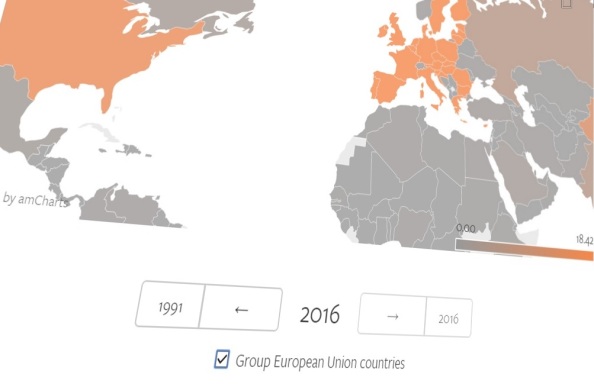 What are the most powerful countries in the world? Which place in the ranking of 168 countries did your country achieve and why? What global trends in terms of politics, culture, geography diplomacy and economics shape the global dynamics today? These are the questions answered by “State Power Index 1991-2017” report I co-authored.
What are the most powerful countries in the world? Which place in the ranking of 168 countries did your country achieve and why? What global trends in terms of politics, culture, geography diplomacy and economics shape the global dynamics today? These are the questions answered by “State Power Index 1991-2017” report I co-authored.
The index, presented on 25th May in the Representation of European Commission Office in Warsaw is one of the first if not the first global index of state power that takes into account the sum of cultural, geographic and diplomatic factors of power, along with economic and military ones (the index consists of 7 subindexes). It is also the first multidimensional country ranking, which measures the performance of the states over last decades. We assess the power of all 168 countries in the world together with the potential of the fully integrated European Union that currently forms a parastate.
Ten most powerful countries according to our index are as follows:
Read more: find your country on the interactive ranking map here, or on the full ranking table that is available here.
Key conclusions
What is interesting, however, is that there exists an invisible, unmentioned leader of this TOP 10 ranking – namely European Union. The index allows for summing up the power of EU members.

It seems that if treated as a profoundly integrated entity, European Union would be the greatest power in the world:

Based on the analysis of international relations and the findings from the ranking itself we concluded that:
- The European Union could be the greatest superpower in the world, if it overcomes the current crisis
- Weaker countries, to remain in relative safety, must group themselves into larger defensive units.
- Forthcoming changes in the balance of power will spawn destabilisation and the threat of war.
- Western countries cannot find themselves in the conditions of hybrid confrontation.
- Deterrence power is not always sufficient and influential individuals play a major role in a country’s international standing.
The report also offers a few conclusions specifically about Poland and the EU:
- Poland’s power is growing (currently 27/168), although Germany (5/168), Great Britain (6/168) and France (7/168) remain the EU’s most powerful nations.
- Although Poland belongs to 20% most powerful countries in the world, it is also relatively weak compared to its powerful neighbours (Russia (3/168) and Germany (5/168)).
Read more: our main conclusions in detail are available here.
Key global trends
The report also elaborates key global trends that will be shaping the world in decades to come.
- China catching up with the US, India on Russia’s heels. Poland’s power is growing
- EU may become a superpower, if it implements reforms and overcomes the crisis
- Three Seas Initiative can strengthen EU’s potential
- Capital is in China and Europe. EU can become a global leader
- Population falling in half of the countries in the world
- US is a global military power, EU could be No. 2

- Natural resources increase the importance of Africa and Middle East
- The Anglo-Saxons shape modern culture
- French and Russians are the best diplomats
Read more: global trends elaborated in detail here.
A word about our methodology and subrankings
Although – due to the evolving nature of international attitudes – we put emphasis of the hard power (economic and military dimensions) we do not neglect soft power, i.e. non-confrontational, more tacit and indirect influence nations have on one another. Our index measures 7 dimensions which attribute different weigh to different sets of factors. The subindexes include the following:
- Economic Subindex (40%)
- Military Subindex (20%)
- Land Subindex (10%)
- Human resources Subindex (10%)
- Culture Subindex (10%)
- Natural resources Subindex (5%)
- Diplomacy Subindex (5%)
Separate ranking maps for all countries are available in case of all 7 subindexes: /1/ economic subindex, /2/ military subindex as well as /3//4/ land and population subindexes, /5/ natural resources subindex, /6/ cultural subindex and /7/ diplomatic subindex.
Read more: our methodology and relevant equations are presented here.
Authors and future editions:
 The report was written by Grzegorz Greg Lewicki (myself) and Piotr Arak for In.Europa in cooperation with Konrad Adenauer Stiftung; it was published as a bilingual publication – in English and Polish languages. Future editions will include significant comparative improvements, such as regional measures of power, graphic country comparisons and other enhancements.
The report was written by Grzegorz Greg Lewicki (myself) and Piotr Arak for In.Europa in cooperation with Konrad Adenauer Stiftung; it was published as a bilingual publication – in English and Polish languages. Future editions will include significant comparative improvements, such as regional measures of power, graphic country comparisons and other enhancements.
The index was published online at www.StatePowerIndex.com and www.index.ineuropa.pl/en
If you are interested in financing our research or cooperating, please contact in@ineuropa.pl.





















Posted on 07/01/2017
0